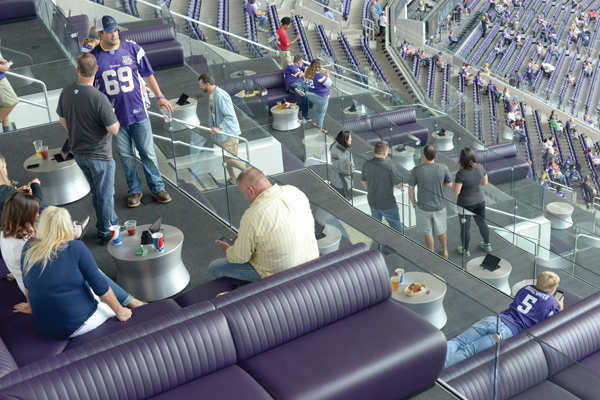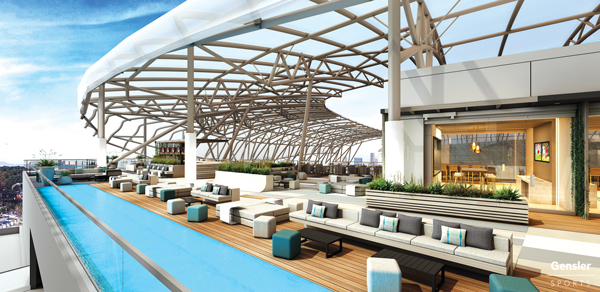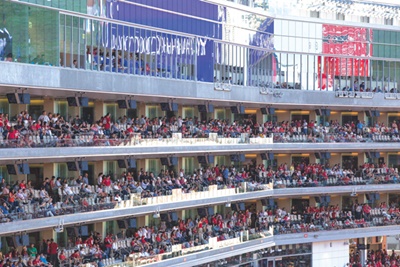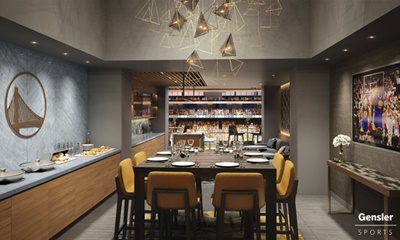 |
Club Purple’s couches at U.S. Bank Stadium invite fans to interact.
Photo by: NANCY KUEHN / MINNEAPOLIS/ST. PAUL BUSINESS JOURNAL |
Premium seating’s shift to mobile and social may sound a lot like apps on your phone or tablet, but it reflects broader themes in our society. As more Americans move back into cities and reconnect with public life, sports sits at the nexus of this urban renewal, providing a modern meeting place.
Despite the power of social media, there’s still demand for old-school, in-person face time and chat sessions. Sports teams and facilities think they have the right spot, with drinks and hors d’oeuvres in a hip common area adjacent to premium seating.
New and refurbished venues not only look but also operate in radically different ways than prior generations of buildings. The Minnesota Vikings’ year-old U.S. Bank Stadium, designed by HKS, is a widely cited example of a new venue that got it right.
“I think the nature of hospitality is changing, the way people entertain clients. It’s not just sitting and watching the game anymore. It’s interacting with other people,” said J.P. Paul, vice president of guest relations and corporate development for the Vikings.
“We have a handful of different areas where people can own a seat and have access to a club, get out of the suite, interact with other fans,” Paul said.
One area that has scored with hometown fans as well as visiting team executives is Mystic Lake’s Club Purple, with its 33 couches, 1,100 seats and numerous screens with fantasy football updates. It has influenced designs in several new arena projects.
Paul says Club Purple has become a big hit with season-ticket holders, quickly selling out. “It’s becoming a community in and of itself. People aren’t confined to a traditional club seat. They can wander around their own space and see another couch owner and interact with them.”
 |
The Sunset Club at Los Angeles Football Club’s Banc of California Stadium (above) and club suite dining at the Golden State Warriors’ Chase Center, two projects now under construction.
Photo by: GENSLER (2) |
It’s not just millennials looking to congregate with peers. Paul points to the corporate set in the Valhalla Suites, which at 17 rows off the playing surface are the NFL’s closest to the field without being field suites themselves. And they access the high-end Founder’s Lounge, where C-suiters can meet up in a social space, too.
“We designed that area so that if the CEO of XYZ Company wants to meet the CEO of ABC Company in an intimate environment, they can get away during the game and do that, but still be near their clients,” Paul said.
Ron Turner is in the middle of this social re-engineering of sports venues, and he says he was there in the beginning. The architect, principal and director of Gensler Sports credits former Cleveland Cavaliers owner Gordon Gund with being in the vanguard of rethinking social sports design. “We brought suites very close to the court” Turner said.
Turner recalls making 3-D models for Gund, who was blind, but who Gensler said could still envision the final results and quizzed designers when they made the slightest changes. Turner also credits Peter Guber with pushing the envelope in building venues for his Los Angeles Football Club, designed by Gensler, and Golden State Warriors, designed by Manica Architecture with interior work by Gensler.
“Revenue and fan experience are their two key issues,” Turner said.
These new types of seating arrangements and shared social spaces are also responses to younger fans wanting a premium product different from prior generations. “They have a completely different viewpoint, and if we don’t address that, they’re not interested,” Turner said.
“In the past five to seven years it’s really changed. Now everybody doesn’t want to go into a suite with 20 people, but some would rather go with their buddies and hang in a little spot but have the ability to go and be with 50 to 60 people or the ability to move around the venue and meet friends on the other side.”
Architects and designers are adding these amenities as they stave off the allure of the excellent at-home viewing experience. “Our clients are scared to death that people will stop coming, but I don’t think that will happen,” Turner said. “You can’t replace the in-person experience, but if you don’t create an interesting place to go, they won’t.”
Turner points to experiential offerings including speakeasies, bunker suites and field clubs at Guber’s new venues.
LAFC’s Banc of California Stadium will also feature a 35,000-square-foot food hall. “It’s going to be a very good experience,” said Turner, comparing it to Eataly, an Italian food hall with several locations in the U.S. “It’s the first time there will be anything like that in a venue. We have a few other clients that want to do the same thing.”
The stadium’s Sunset Club will include an area to socialize that’s true to its L.A. roots: a pool deck.
 |
The San Francisco 49ers had suites at Levi’s Stadium designed with flexibility in mind.
Photo by: VICKI THOMPSON / SILICON VALLEY BUSINESS JOURNAL |
San Francisco 49ers President Al Guido agreed that the premium business had changed. “How one buys a ticket or box is very different from what it used to be. … Shared social experiences are very different from what they used to be,” he said.
“In the old days you’d build premium spaces in areas you had difficulty selling. In old NBA arenas that was behind the basket. Today you’d never think about doing that. The easy answer is put your premium seats where the best seats are and you’ll get the most money for them.”
NBA teams such as the Warriors and Atlanta Hawks are employing that model as they work on arenas.
Guido, who has a long history in premium sales going back through roles with Legends and the Dallas Cowboys, says people are doing more networking and want to break out of the suite to engage with others.
“We’ve found that people who buy boxes find it limiting to only talk to the 20 individuals they invited to the box,” he said. “Now there’s social selling. … Take 20 boxes times 20 people, put in a larger environment and there’s more opportunities to network.”
“Design thought process has changed dramatically in the stadium business,” Guido said. He notes that newer venues like his club’s home, HNTB-designed Levi’s Stadium, are built for a busier slate of events outside of football. “Spaces you can mix and match with any product or concept at a given time,” he said, noting that the stadium’s suites are built in a way that they can be changed to create club seats or loge seats.
Although adding options and experiences can be entertaining, Guido still contends that attention should remain squarely on the field. “I believe people want to be part of the broader environment, screaming and yelling,” he said. “Passive environments may attract people to games, but it’s not creating fans.”
There’s no one-size-fits-all solution for social spaces. Team execs say this fact comes into focus as they do their homework before building out or refurbishing structures.
Stew MacDonald, executive vice president of revenue for Oilers Entertainment Group, says the executive team toured more than 40 venues in North America and then did focus groups, testing premium concepts with premium-seat holders, other ticket holders and some sponsor clients, before erecting Rogers Place, designed by HOK.
“The all-new [premium] products contained privately accessible but broadly available social spaces to those groups,” MacDonald said. “Research was the key — going in and testing with our current base and prospects — and it has met their expectations.
“In Northern Alberta we’re more small business than corporate main office.
“Our customers want the ability to socialize and network. That’s key in justifying the price of this product.”
The Oilers found smaller sets of seats and areas to socialize “were the keys to the design,” he said.
Another convenience that many premium fans desire is the ability to visit other areas in the arena. MacDonald points out that Rogers Place includes a private walkway from one club space to another.
Shared social spaces in the premium-seating areas can be nirvana for brands that can activate and spend time with a target market.
Nick Kelly, senior director of experiential marketing for Anheuser-Busch InBev, says that until recently many “upper echelon” guests would never reappear after going to their seats. “Now local high-end chefs are cooking there, we’re doing higher-end beer opportunities — beer flights or beer school, or unique brews only at that venue.”
Kelly says Anheuser-Busch InBev is looking for more than tap space, so these types of premium social spaces work well.
“We have brand awareness. That’s not a problem for us. The last thing we need is another sign,” Kelly said. “We want to control the ultimate beer experience. We have the opportunity to activate here and tell the story of stay-fresh beer. It was brewed and put in kegs down the street and you have it today and we have a brewmaster on hand to tell you about it. I can’t do that on the concourse.”
And, Kelly said, “Unlike an insurance company and car company, we can come in and enhance the experience authentically and play a role.”
Robert Gray is a writer in California.







